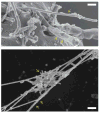Biological interactions of carbon-based nanomaterials: From coronation to degradation
- PMID: 26707820
- PMCID: PMC4789123
- DOI: 10.1016/j.nano.2015.11.011
Biological interactions of carbon-based nanomaterials: From coronation to degradation
Abstract
Carbon-based nanomaterials including carbon nanotubes, graphene oxide, fullerenes and nanodiamonds are potential candidates for various applications in medicine such as drug delivery and imaging. However, the successful translation of nanomaterials for biomedical applications is predicated on a detailed understanding of the biological interactions of these materials. Indeed, the potential impact of the so-called bio-corona of proteins, lipids, and other biomolecules on the fate of nanomaterials in the body should not be ignored. Enzymatic degradation of carbon-based nanomaterials by immune-competent cells serves as a special case of bio-corona interactions with important implications for the medical use of such nanomaterials. In the present review, we highlight emerging biomedical applications of carbon-based nanomaterials. We also discuss recent studies on nanomaterial 'coronation' and how this impacts on biodistribution and targeting along with studies on the enzymatic degradation of carbon-based nanomaterials, and the role of surface modification of nanomaterials for these biological interactions.
From the clinical editor: Advances in technology have produced many carbon-based nanomaterials. These are increasingly being investigated for the use in diagnostics and therapeutics. Nonetheless, there remains a knowledge gap in terms of the understanding of the biological interactions of these materials. In this paper, the authors provided a comprehensive review on the recent biomedical applications and the interactions of various carbon-based nanomaterials.
Keywords: Bio-corona; Biodegradation; Carbon nanotubes; Fullerenes; Graphene oxide; Nanodiamonds.
Copyright © 2015 The Authors. Published by Elsevier Inc. All rights reserved.
Conflict of interest statement
Conflict of interest: The authors declare no conflicts of interest.
Figures





References
-
- Fadeel B. Nanosafety: towards safer design of nanomedicines. J Intern Med. 2013;274:578–80. - PubMed
-
- Langer R, Weissleder R. Nanotechnology. JAMA. 2015;313:135–6. - PubMed
-
- Mundra RV, Wu X, Sauer J, Dordick JS, Kane RS. Nanotubes in biological applications. Curr Opin Biotechnol. 2014;28:25–32. - PubMed
-
- Chen D, Dougherty CA, Zhu K, Hong H. Theranostic applications of carbon nanomaterials in cancer: focus on imaging and cargo delivery. J Control Release. 2015;210:230–245. - PubMed
-
- Tonelli FM, Goulart VA, Gomes KN, Ladeira MS, Santos AK, Lorençon E, et al. Graphene-based nanomaterials: biological and medical applications and toxicity. Nanomedicine (Lond) 2015;10:2423–50. - PubMed
Publication types
MeSH terms
Substances
Grants and funding
LinkOut - more resources
Full Text Sources
Other Literature Sources
Miscellaneous

